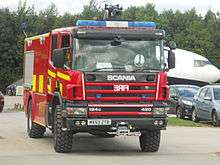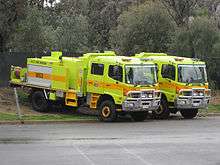Fire engine red
Fire engine red is an informal name for an intense, bright red commonly used on emergency vehicles in some English-speaking countries on fire service vehicles. There is no unique shade, although different fire services may have a required specification.[1][2] The color has long been used,[3] although not by all fire vehicles.
| Fire engine red | |
|---|---|
| Hex triplet | #CE2029 |
| sRGBB (r, g, b) | (206, 32, 41) |
| CMYKH (c, m, y, k) | (0, 89, 80, 19) |
| HSV (h, s, v) | (357°, 89%, 81%) |
| Source | [1] |
| ISCC–NBS descriptor | Vivid red |
| B: Normalized to [0–255] (byte) H: Normalized to [0–100] (hundred) | |
Background
Traditional fire departments in large U.S. central cities and major metropolitan areas use this color on fire engines, but many suburbs and smaller cities use the color lime or bright yellow for their fire engines because of its greater visibility at night. In the U.K. the fire service added the more visible Battenburg markings in fire-engine red and retro-reflective yellow, often on a predominantly red vehicle.[4]
Initial research into fire appliance visibility was conducted by the Lanchester College of Technology and the Fire Brigade in Coventry, in the UK in c. 1965. It concluded that under the range of artificial street lighting in common use at the time, yellow better retained its conspicuity than red. Yellow was also more conspicuous in general road conditions in the daytime and during inclement weather. Research conducted by Stephen Solomon, a New York optometrist, promoted the use of "lime yellow" in the United States from the mid-1970s. Solomon conducted studies of the rate of vehicle accidents involving fire apparatus, concluding that the more conspicuously colored fire apparatus suffered a lower accident rate than the less conspicuous red used by the same fire department.[5][6]
Further research supporting the use of yellow for all emergency vehicles was published in 1978 in Australia.[7]
 Support 42 in Butte County, California.
Support 42 in Butte County, California. Red fire appliance with half-Battenburg side markings at Manchester Airport
Red fire appliance with half-Battenburg side markings at Manchester Airport ACT Fire and Rescue tankers in Chartreuse yellow
ACT Fire and Rescue tankers in Chartreuse yellow
See also
- Green Goddess
- International orange
- List of colors
- Safety orange
- School bus yellow
References
- "Fire Engine Red". FindTheBest.com. Archived from the original on 2017-03-11. Retrieved 1 January 2014.
'Fire Engine Red' is a shade of Red that is 84% saturated and 81% bright. It has the hex value #CE2029. Pantone color #1795 is a 96% match.
- "Frequently Asked Questions (about fire vehicles)". John Dennis Coachbuilders. Retrieved 22 November 2016. "The most popular shade of red is Post Office Red (BS381c538)" This is a cherry red, #9D383A
- "Dennis Fire Engine – Trailer Pump of 1913". Dennis Society (concerning Dennis fire vehicles). Retrieved 22 November 2016.
- EXPLANATORY MEMORANDUM TO THE ROAD VEHICLES LIGHTING AND GOODS VEHICLE (PLATING AND TESTING) (AMENDMENT) REGULATIONS 2009, UK Department of Transport
- Solomon SS (1990). "Lime-yellow color as related to reduction of serious fire apparatus accidents—the case for visibility in emergency vehicle accident avoidance". J Am Optom Assoc. 61 (11): 827–31. PMID 2081824.

- Solomon, S. S.; King, J G (1995). "Influence of Color on Fire Vehicle Accidents". Journal of Safety Research. 26 (1): 41–48. doi:10.1016/0022-4375(95)00001-1.

- Green, David A. (1978). Emergency vehicle warning systems and identification. NSW Public Works Department. 24pp. ISBN 0724047956.